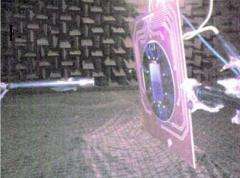November 4, 2009 feature
Tiny Music Player Made from Wire Bridge (w/ Video)

(PhysOrg.com) -- In 2008, scientists built a loudspeaker made of carbon nanotubes that produced sound and music based on the thermoacoustic effect. Now, a different team of scientists has built a loudspeaker made of tiny aluminum wires suspended like a bridge between two supports, producing sound in a similar way. The new wire bridge also has the advantage of being much easier to fabricate than the nanotube device, offering the potential for a wide range of audio applications.
A. O. Niskanen, et al., from the VTT Technical Research Center of Finland and the Helsinki University of Technology, have published their study on the sound-producing wire bridge in a recent issue of Applied Physics Letters. In experiments, the scientists constructed several versions of the aluminum wire bridge, using between 6,000 and 233,000 wires. Each wire was about 200 micrometers long, 3 micrometers wide, and 30 nanometers thick. The ends of the wires were clamped to supports to form “air bridges,” hovering a few microns above the substrate underneath.
Like the nanotube loudspeaker, the wire arrays also use the thermoacoustic effect to produce sound. When a voltage is applied to the conductive aluminum wires, it creates temperature variations in the wires proportional to the voltage. In turn, these temperature variations create pressure variations in the air, which are sound waves. By adding a dc bias, the scientists could enable the loudspeakers to produce speech and music.
“The thermoacoustic effect utilizes the fact that sound, i.e. adiabatic pressure fluctuation of air, is accompanied by fluctuation in air temperature,” coauthor Juha Hassel of the VTT Technical Research Center of Finland told PhysOrg.com. “Conversely, it is possible to generate sound thermally, by varying rapidly the air temperature. This is how our sound generator works. Electrical heating power on the device surface is converted to a corresponding acoustic pressure. To linearize the acoustic response to voltage or current, a dc bias is superposed on the speech or music signal.”
Audio measurements showed that the loudspeakers could generate high-pressure sound waves up to 110 decibels at a distance of 8 cm. The thermoacoustic effect is more suitable for producing higher frequency sounds, such as ultrasound, and the scientists found that the device could produce sounds with frequencies up to 40,000 Hz, well beyond the normal human hearing range of 20 - 20,000 Hz.
The scientists predict that the thermoacoustic speakers could be used in ultrasound applications, such as SONARs ("sound radars"), gas sensors, and distance sensors. The simplicity of the basic structure could also be used to create phased array ultrasound sources. Phased arrays are used for constructing an ultrasound beam of a desired shape by driving different loudspeakers (or wires) at different phases. As the scientists explain, the fabrication process is very simple compared to other microelectronics processes, and could easily be incorporated into a more complicated process.
“The method allows development of applications even on the industrial scale,” said Hassel. “We believe that such simple technology could be especially useful in ultrasound applications, possibly replacing the conventional piezoelectric actuators in some cases. Our ongoing experimental and theoretical work aims towards a better understanding of the properties of the technology to be able to evaluate its full potential.”
More information: A. O. Niskanen, J. Hassel, M. Tikander, P. Maijala, L. Grönberg, and P. Helistö. “Suspended metal wire array as a thermoacoustic sound source.” Applied Physics Letters 95, 163102 (2009)
Copyright 2009 PhysOrg.com.
All rights reserved. This material may not be published, broadcast, rewritten or redistributed in whole or part without the express written permission of PhysOrg.com.


















